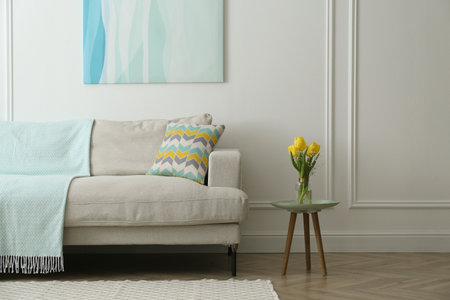Introduction to Feng Shui in Modern British Homes
In recent years, the ancient Chinese art of Feng Shui has found a unique and increasingly prominent place within contemporary British living rooms. Traditionally rooted in the harmonious arrangement of space to promote well-being, prosperity, and balance, Feng Shui principles are now being embraced by homeowners across the UK who seek not only stylish interiors but also positive energy flow within their domestic environments. As British lifestyles evolve and become more attuned to holistic well-being, the relevance of Feng Shui has grown beyond mere aesthetic appeal. It now represents a thoughtful approach to design that takes into account both practical comfort and deeper psychological benefits. This integration of Eastern philosophy with Western sensibilities has seen British living spaces transformed into sanctuaries that reflect both cultural heritage and modern living needs. Whether through carefully chosen artwork, strategic ornament placement, or mindful furniture arrangement, Feng Shui offers UK residents a way to create homes that are both beautiful and balanced—inviting in good fortune while fostering a sense of peace and connection in everyday life.
2. Integrating Eastern Philosophy into British Interior Design
Embracing Feng Shui within the context of a contemporary UK living room involves a delicate balance between Eastern philosophy and the quintessentially British approach to interior design. While Feng Shui emphasises harmony, flow, and the placement of objects to encourage positive energy (Qi), traditional British homes are often defined by their unique architectural features—such as bay windows, ornate fireplaces, and period cornices. The fusion of these elements requires thoughtful consideration of both aesthetic sensibilities and spatial arrangements.
Understanding Contrasts and Synergies
British interiors typically celebrate comfort, understated elegance, and historic character, whereas Feng Shui principles prioritise balance, decluttered spaces, and purposeful ornamentation. By integrating both philosophies, homeowners can create living rooms that are not only visually pleasing but also promote well-being. This integration is particularly evident in how colours, materials, and furniture placement are selected to reflect both traditions.
Key Elements: A Comparative Overview
| Feng Shui Principle | British Design Element | Integration Strategy |
|---|---|---|
| Open Flow of Qi | Cosy Corners & Nooks | Create open pathways around classic seating arrangements without sacrificing intimacy. |
| Natural Materials | Wooden Floors & Fireplaces | Highlight wooden features with minimalistic Eastern-inspired ornaments. |
| Balance of Five Elements | Layered Textiles & Patterns | Introduce earth tones and subtle motifs in cushions or rugs to represent elemental harmony. |
Cultural Sensitivity in Ornament Placement
The successful blending of Feng Shui art with British décor hinges on mindful ornament placement. For instance, placing a jade sculpture near a sash window may invite light and energy while respecting the room’s historic charm. Similarly, incorporating water-themed artwork above a Victorian mantelpiece can symbolise abundance without clashing with heritage features. By weaving together these cultural threads, UK homeowners can craft living rooms that honour tradition yet remain unmistakably modern.

3. Positioning Feng Shui Artworks in UK Living Rooms
When integrating Feng Shui artworks into contemporary British living rooms, careful consideration of both placement and subject matter is essential to harmonise energy flow and respect the unique character of UK interiors. Traditional British homes often feature fireplaces, bay windows, and alcoves—architectural details that provide natural focal points for artwork. To optimise positive chi, it is advisable to hang serene landscapes or water-themed paintings on the north-facing walls, symbolising calmness and career advancement. For rooms with prominent mantels, select art pieces that evoke warmth or prosperity, such as gentle mountain scenes or blossoming florals, ensuring they sit at eye level to invite uplifting energy. Modern British living rooms, which may favour open-plan layouts and neutral palettes, benefit from minimalistic yet meaningful Feng Shui art; abstract representations of the five elements can subtly enhance balance without overwhelming the space. When choosing frames or ornaments, opt for materials like wood or metal that echo the room’s existing finishes—this continuity supports both aesthetic coherence and energetic alignment. Avoid positioning aggressive or chaotic imagery above seating areas, as this may disrupt relaxation and conversation. Instead, consider placing pairs of harmonious artworks on either side of French doors or windows to symbolise partnership and unity—values deeply rooted in both British culture and Feng Shui philosophy.
4. Selecting Ornaments: Balancing Energy and Aesthetic
When choosing ornaments for a contemporary UK living room with Feng Shui in mind, it is essential to find a balance between energetic harmony and the refined tastes prevalent in British interiors. This process involves more than simply selecting attractive pieces; it requires thoughtful consideration of both the symbolism behind each object and its visual contribution to the space.
Understanding Feng Shui Symbolism
Feng Shui places importance on certain shapes, materials, and colours that represent elements such as wood, water, fire, earth, and metal. These can be incorporated through ornaments like ceramic vases (earth), wooden sculptures (wood), or metallic candle holders (metal). When integrating these elements into a UK home, it’s wise to select items that also complement British sensibilities—think classic blue-and-white ceramics or sleek copper accents.
Current UK Design Trends
Contemporary British interiors often favour a blend of tradition and modernity—neutral palettes, clean lines, and occasional bursts of bold colour. The key is to choose decorative objects that feel current yet timeless, such as minimalist glass bowls, botanical prints, or heritage-inspired pottery.
Ornament Selection Guide
| Feng Shui Element | Recommended Ornament | UK Design Example |
|---|---|---|
| Wood | Carved Oak Figurine | British Arts & Crafts Style Piece |
| Water | Blue Glass Vase | Cotswolds Studio Glassware |
| Fire | Candle Holder | Copper Lantern from John Lewis |
| Earth | Ceramic Bowl | Handmade Stoke-on-Trent Pottery |
| Metal | Brass Picture Frame | Victorian-Inspired Frame from Liberty London |
Tips for Harmonising Energy and Aesthetics
- Select ornaments with smooth edges to encourage positive energy flow.
- Avoid overcrowding surfaces; allow each piece space to ‘breathe’.
- Opt for pairs or groupings of three to promote balance according to Feng Shui principles and British design symmetry.
The artful selection of ornaments becomes an act of mindful curation—one that pays homage to both ancient Eastern wisdom and contemporary British style. By thoughtfully blending these influences, your living room becomes not just a visual delight but also a sanctuary of harmonious energy.
5. Practical Challenges and Solutions
Integrating Feng Shui art and ornament placement within contemporary UK living rooms is not without its unique set of challenges. British homes, with their diverse architectural styles—from Victorian terraces to modern flats—often present spatial constraints or conflicting design elements that can make traditional Feng Shui application less straightforward. Recognising these obstacles is the first step towards achieving harmony between Eastern philosophy and Western living spaces.
Common Obstacles in British Homes
One frequent issue is limited space, particularly in city flats where open-plan layouts are common. This can make it difficult to create distinct zones for the five elements or to position ornaments according to classic compass directions. Another challenge is the prevalence of built-in features such as fireplaces or radiators which may restrict ideal placement of mirrors, plants, or water features. Additionally, longstanding British décor traditions—think bold wallpaper, heavy curtains, or inherited heirlooms—may clash visually with minimalist Feng Shui ornaments.
Practical Solutions for Harmonious Integration
To overcome these hurdles, flexibility and creative adaptation are key. For smaller living rooms, consider using multi-functional pieces—like a decorative bowl doubling as a water element—or wall-mounted shelves for displaying crystals and lucky bamboo without cluttering surfaces. When traditional placements are blocked by built-in features, opt for symbolic substitutes; a mirror above a fireplace can ‘double’ prosperity even if it isn’t perfectly aligned with the wealth area. Embrace existing British décor by selecting Feng Shui ornaments that complement local aesthetics—such as ceramic vases in heritage colours or artwork depicting both Chinese motifs and familiar UK landscapes.
Balancing Authenticity with Personal Taste
Ultimately, successful Feng Shui in a UK context means balancing authenticity with personal taste. It’s perfectly acceptable to adapt guidelines so that your living room remains both culturally meaningful and distinctly British. Seek out expert advice from practitioners familiar with Western interiors, experiment with small changes before committing to major rearrangements, and most importantly, trust your intuition—after all, the goal is to create a space where you feel truly at home.
6. Case Studies: British Homes Embracing Feng Shui
Across the United Kingdom, a growing number of homeowners are weaving the ancient wisdom of Feng Shui into the fabric of their modern living rooms. This section explores real-life examples from various regions, highlighting how British sensibilities blend harmoniously with Eastern philosophy to create balanced, inviting spaces.
Urban Flat in London: Modern Minimalism Meets Energy Flow
In the heart of London, a young couple residing in a compact flat chose to introduce Feng Shui principles through mindful placement of art and ornaments. By positioning a round mirror on the north wall—enhancing water energy—they achieved an illusion of depth and improved light distribution. Carefully selected abstract paintings with gentle curves, placed above a neutral sofa, invite calm and creativity while avoiding harsh geometric shapes that could disturb energy flow. Their coffee table hosts a small jade plant, symbolising growth and vitality, ensuring prosperity is always at hand.
Victorian Home in Bath: Tradition Reimagined
An established family in Bath embraced Feng Shui by incorporating heritage-inspired yet energetically attuned décor. They positioned a pair of blue-and-white porcelain vases symmetrically on the mantelpiece, representing balance and unity. Artwork depicting serene landscapes was hung on the east wall to encourage family harmony and health, while a crimson ceramic bowl filled with polished stones anchors the room’s centre—enhancing stability and grounding energy without disrupting the Victorian aesthetic.
Cotswolds Cottage: Rustic Harmony
Amidst rolling hills, a renovated Cotswolds cottage stands as testament to thoughtful integration of Feng Shui within quintessentially British interiors. The homeowners opted for hand-painted watercolour prints featuring native flora and fauna, strategically placed to attract positive chi (energy). Vintage brass ornaments shaped as hares and foxes sit on wooden shelves in pairs, fostering companionship and warmth. A woven wool rug in calming earth tones defines the seating area, promoting comfort while subtly adhering to the elemental balance prescribed by Feng Shui.
Insights from UK Homeowners
Feedback from these homeowners reveals that integrating Feng Shui has not only elevated their living room aesthetics but also contributed to greater well-being and contentment. Many note an increased sense of tranquillity and improved social interactions within these revitalised spaces. It is clear that when approached with respect for both tradition and personal taste, Feng Shui art and ornament placement can seamlessly enrich contemporary UK living rooms—creating sanctuaries where East meets West in effortless harmony.

